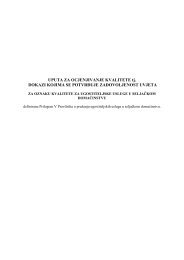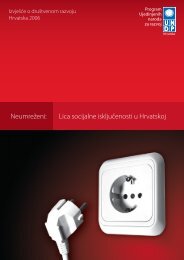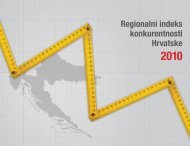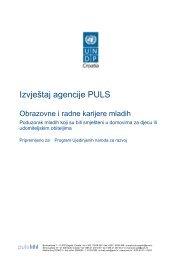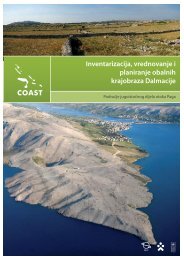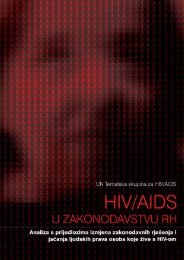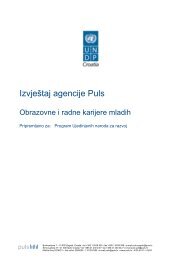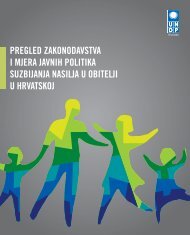WEB engleska verzija end.indd - UNDP Croatia
WEB engleska verzija end.indd - UNDP Croatia
WEB engleska verzija end.indd - UNDP Croatia
- No tags were found...
Create successful ePaper yourself
Turn your PDF publications into a flip-book with our unique Google optimized e-Paper software.
THE SOCIALLY EXCLUDEDCHAPTER 3Such age structure has numerous serious consequences:- High consumption of health and social servicesconsidering the high old-age dep<strong>end</strong>ency ratesillustrate the potential social support needsand possibly the need for changes in the waycommunity resources are shared betweengenerations.- Ability of the population to actively participatein economic development and production islimited.- There are limited free market capital investmentsinto areas with such demographic statistics.- All of these factors may contribute to a wideningdevelopment gap and increasing inequality.Although the absolute poverty rate in <strong>Croatia</strong> is low byinternational standards, it does not adequately reflectcounty-specific conditions. Poverty rates are higher inrural areas, among poorly educated individuals andthe elderly, which describes most returnees. Nationalunemployment is officially 17.2%, however it can beas high as 34.2% 67 in some return areas where fragilepre-war economic infrastructure has collapsed leavinglittle prospect for revitalization. High unemploymentrates and an overall difficult socio-economic environmentare affecting the whole population, weakeningthe community’s ability to secure the vulnerable.Statistical data from the Ministry of Health and SocialWelfare 68 shows that 2.7% of the national populationreceive social welfare support benefits. 69 However, incounties with high return rates this percentage canbe as high as 5% in Karlovac county or even 10.1% inŠibenik-Knin county. At the municipal level, this ratecan rise even further – Vojnić 11.2%, Topusko 12%,Obrovac 14.8%, Gračac 17.1% and Knin 30%. All ofthese municipalities have high numbers of Serb returnees.Comprehensive development programmesshould focus on the overall improvement of all areasof return (including the economy, infrastructure, education,social welfare, health, etc). Otherwise, if negativeconditions continue or worsen, they will not onlynegatively affect the sustainability of return, but canbecome a cause of secondary displacement, plantingthe seeds of fresh discontent and renewed tensions.The data on trust in the social welfare system fromthe <strong>UNDP</strong> Quality of Life survey also provides insightregarding whether returnees are able to socially reintegrateinto a favourable environment. Almost halfthe population (43.1%) in <strong>Croatia</strong> are dissatisfied withthe ability of the healthcare system to adequatelyprovide services while distrust in the social welfaresystem exceeds 50%. Counties affected by the warand that are home to a high number of returnees(e.g. counties of Zadar and Šibenik-Knin as well ascounties in Slavonia) emphasize their dissatisfactionwith social welfare services. Consequently, returneesand refugees display more dissatisfaction with theseservices and feel the environment is not favourablefor reintegration. Elderly people throughout <strong>Croatia</strong>also show distrust in the state pension system, butespecially in the war-torn counties of Zadar andVukovar-Srijem. Very low pensions cause feelings ofsocial and economic insecurity among returnees.The state welfare system in the areas of return is oftenunderdeveloped and already overburdened, therebyweakening its ability to meet the needs of vulnerablereturnees. For example, Lika-Senj County is the oldestcounty in <strong>Croatia</strong> with an average age of 43 and atthe same time one of the least developed. However,only 2.2% of the population receives support fromthe Ministry for Health and Social Welfare. This is aresult of the very low population density (the lowestin <strong>Croatia</strong>) of 10 people per km2, difficult terrain andan undeveloped social services system. Elderly andvulnerable people living in these areas have limitedaccess to social welfare services and social servicesprovided by mobile teams from local NGOs, such asthe <strong>Croatia</strong>n Red Cross. The overburdened system isill-equipped to provide the quantity and quality ofservices beyond the bare minimum.Since the ODPR does not provide social care to returneesin their facilities, local ODPR offices are expectedto refer cases to the Centres for Social Welfare (CSW).The CSWs usually refuse to take care of returnees67 Vukovar county - The latest official data on unemployment rate per county available for 200468 Official data from the Ministry of Health and Social Welfare as of September 30, 200569 Support benefit is just one of seventeen different benefits/services provided by Ministry of Health and Social Welfare. Local administrations(counties, municipalities) provide different social benefits from their budgets.55



